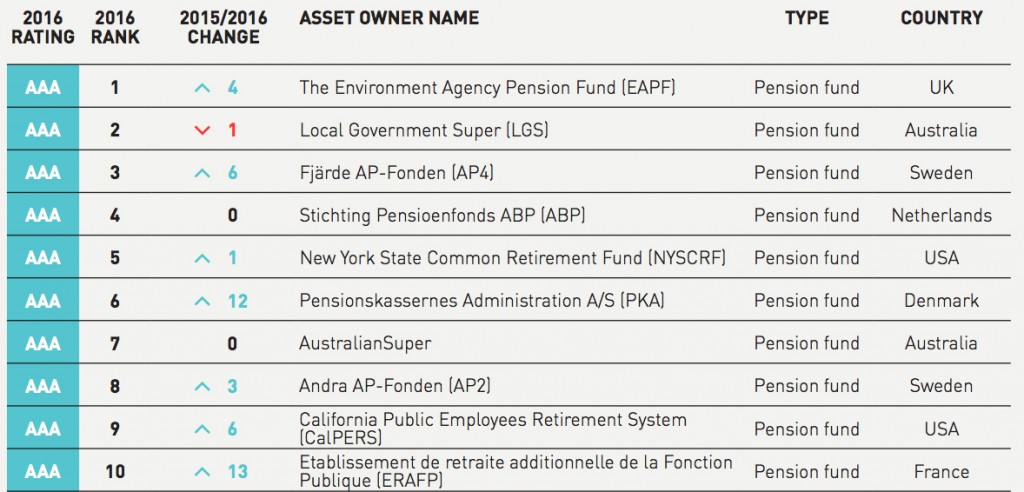Leo Kolivakis is a blogger, trader and independent senior pension and investment analyst. This post was originally published at Pension Pulse.
Attracta Mooney of the Financial Times reports, The US public pensions crisis ‘is really hard to fix’:
Eighteen months after Rahm Emanuel, a former White House chief of staff, became mayor of Chicago, he addressed a news conference about his priorities.
“[Number] one is retirement security and pension reform so we can give taxpayers and the public employees retirement security, which is something we can’t say today,” the mayor said in November 2012.
In the following three and a half years, Chicago’s public pension system, which estimates suggest has a funding hole of between $20bn and $32.5bn, has cast a long shadow over the mayor.
There have been rows with unions, court battles and finally a credit downgrade for the city, all linked to the Chicago’s public pensions.
Similar stories are playing out across the US. Although the funding deficits might not be as extreme as in Chicago, many cities and states are struggling under the weight of their pension plans, which oversee the retirement incomes of current and past public sector employees.
The scale of this pension crisis, as it has been dubbed, is huge. The Hoover Institution, a think-tank at Stanford University, estimates that US public pensions collectively have a $3.4tn funding hole. More conservative numbers put the funding gap at around $1tn.
Few public pension plans are fully funded, meaning they do not have enough money to pay current and future retirees. And the situation is getting worse.
According to Wilshire Consulting, an investment advisory company, state-sponsored pension plans in the US had just 73 per cent of the assets they needed in mid-2015, down from 77 per cent in 2014. Turbulent market conditions in the latter part of 2015 and early 2016 probably made this number even worse.
The big questions are if and how the large funding holes that have emerged in the US public pension system can be fixed.
Chris Tobe, an investment consultant and author of Kentucky Fried Pensions, a book examining problems in Kentucky’s retirement system, says the shortfalls in most US public pension plans are fixable, but there are exceptions, such as Chicago.
However, fixing the schemes will require a lot of work and is likely to have unpleasant consequences for retirees, employees, taxpayers and politicians.
One area where this is apparent is when state and local governments increase or introduce taxes, using the money raised to plug pension shortfalls. Several cities, including Chicago and Philadelphia, have taken this route.
But higher taxes or the issuance of bonds, another option used by local governments to raise money in order to reduce pension deficits, often proves unpopular with taxpayers.
Tamara Burden, principal at Milliman Financial Risk Management, an investment adviser to pension funds, says: “Raising taxes and issuing bonds means a vote, and a lot of public entities have seen those initiatives not pass.
“[The large-scale underfunding of public pensions] is really hard to fix.”
In Chicago, Ed Bachrach, chairman of the Center for Pension Integrity, a non-profit organisation, estimates that to ensure the city’s pension plans are fully funded within 20 years, Chicago’s property tax would have to be increased 85 per cent. But he warns that “crippling tax increases” could drive taxpayers and businesses away.
Mr Bachrach adds: “In troubled jurisdictions, officials cannot raise taxes fast enough to prevent the erosion of fund assets, and the enormous pension payments required are crowding out expenditure for vital public services and crumbling infrastructure.”
There are other options available to improve the outlook for public pension plans. One is making changes within pension funds that would help to drive funding deficits down, such as cutting the fees retirement plans pay to asset managers. Some pensions are pushing into riskier assets in the hope that this will increase returns.
Alternatively, state and local governments could reduce benefits for current or future retirees, or cap the maximum retirement benefit that can be paid to an individual. These measures are illegal in some states and have proved unpopular with unions and public sector workers.
Public sector workers could also be forced to increase their contributions, or moved into defined contribution plans, which do not guarantee a level of income on retirement. This would, in turn, reduce the strain on local government budgets.
Any attempt to fix the pension shortfall is likely to involve a combination of these solutions. But there seems to be an unwillingness to fix the problems, according to Olivia Mitchell, a professor at the Wharton School at the University of Pennsylvania.
Unions, public sector employees and retirees do not want to give up the benefits promised to them, politicians do not want to impose tax hikes that could cost them votes, and taxpayers are reluctant to part with more cash to prop up the system.
Ms Mitchell says: “Politicians and taxpayers have shown themselves unwilling to take their public pension shortfalls seriously.”
Mr Bachrach adds: “Fixing this problem requires shared sacrifice from all parties: public employees, retirees and taxpayers. It requires courage on the part of elected officials.”
If the problems are not fixed, the consequences could be dire.
Some pension funds, including two of Chicago’s plans, are on course to run out of money within a matter of years. This means that either the retirees will not get paid the money they are owed, or, more likely, the cities and states that back the pension plans will have to cover the retirement payments.
This would leave cities and states with less money to spend on services such as education. In some cases, cities may go bankrupt. This has already happened in Detroit in Michigan and San Bernardino in California, where large public pension shortfalls contributed to the cities’ defaults.
“I do believe that US cities and towns will continue to suffer [because of their pension funding holes], and there will be additional bankruptcies following the examples of Detroit,” said Ms Mitchell earlier this year.
Some pension officials are hoping the federal government will step in and prop up problematic retirement funds. But Devin Nunes, a US Republican congressman, is trying to make sure this does not happen.
He proposed a bill in March to ensure the federal government cannot rescue insolvent public pension funds. “Cities and states should run [pension funds] in a financially sustainable way. That is what my bill encourages, particularly by prohibiting federal bailouts of distressed funds,” he says.
Even without the bill, Steven Hess, an analyst at Moody’s, the rating agency, says states and cities will have to fix their own pension problems. “We don’t think the federal government will come to the rescue of municipal plans,” he says.
Phil Angelides, a former state treasurer for California who used to sit on the board of Calpers and Calstrs, the US public pension schemes, says: “[The public pension deficit] is manageable if society begins to address it. A few pension funds may have immediate issues, but they face long-term challenges and there is still time to address them.”
As for Chicago, the future of its pension funds remains unclear. In March, Illinois’s Supreme Court ruled against Mr Emanuel’s plans to stabilise the pension funds by requiring larger employee contributions and cutting pension benefits in return for bigger contributions from the city.
In the wake of this ruling, a spokesperson for the mayor says: “We are currently evaluating a number of pension reform proposals.”
The mayor, it seems, faces an uphill battle to plug the city’s pension deficit.
US public pensions: ‘There is no young blood coming in’
The large funding holes that have emerged at US public pension plans have been decades in the making.
A combination of factors, ranging from demographics to current low interest rates, has left pension plans nursing big deficits.
In some cases, cities and state governments have not contributed as much as they should have to public pension plans, leaving funds without the money they needed to invest and plug any developing funding holes.
Another factor is that public pension plans have been underestimating how much money they would need in future, says Olivia Mitchell, a professor at the Wharton School at the University of Pennsylvania.
Public plans typically have high return targets of between 7 and 8 per cent, which are used to forecast how much money a pension fund will need to pay current and future retirees. Private sector pension plans, in contrast, typically use lower rates of 2.5 per cent on average to calculate future liabilities, says Ms Mitchell.
Every time a public pension plan misses the return target, their liabilities jump. They then need far stronger performance the following year in order to correct the problem.
An ageing public sector population is not helping matters. “There is no young blood coming in to keep their plans going,” says Ms Mitchell.
I’ve already covered why U.S. public pensions are doomed. It’s a slow motion train wreck and while demographics and historic low rates aren’t helping, in my opinion, terrible pension governance is equally if not a more important determinant of the U.S. public pension crisis.
Here are some of the points I noted on why this crisis isn’t going away:
The critical point to remember is that when rates are at historic lows, every drop in global long bond yields represents a huge increase in future liabilities for pensions. Why? Because the duration of liabilities is a lot bigger than the duration of assets which means that every drop in bond yields disproportionately impacts pension deficits.
This is why you see Canada’s large public pensions scrambling to buy infrastructure assets like London City Airport at a hefty premium. They need to find assets that are a better match to their long dated liabilities. We can argue whether Canada’s mighty pensions are paying too much for these “premium infrastructure assets” (I think so) but this is the approach they’re taking to defy volatile public markets and find a better suitable match for their long dated liabilities.
And unlike the United States, Canada’s large public pensions have the right governance to go out to do these direct investments in infrastructure. Also, unlike their U.S. counterparts, Canada’s large public pensions have realistic investment assumptions and are better prepared for an era of lower returns.
In the U.S., public pensions are delusional, firmly holding on to the pension rate-of-return fantasy. They’re also held hostage by useless investment consultants that shove them in the same brand name private equity funds and hedge funds. This doesn’t always pan out well for these public pensions but it enriches private equity titans and hedge fund gurus who collect outrageous fees no matter how well they perform.
It’s worth noting none other than Warren Buffett came out this weekend to state hedge funds are getting ‘unbelievable’ fees for bad results:
“There’s been far, far, far more money made by people in Wall Street through salesmanship abilities than through investment abilities,” Buffett said Saturday during Berkshire’s annual meeting in Omaha, Nebraska.
I couldn’t agree more. I don’t pity any hedge fund manager, especially those “superstars” managing multibillions, collecting a big management fee no matter how poorly they’re performing.
The amount of nonsense governing hedge fund investments at U.S. public pensions is a byproduct of a few things: 1) delusional public pension fund managers who don’t know the first thing about managing a portfolio off hedge funds and 2) this irrational thirst for yield at all cost believing that hedge funds can offer great risk-adjusted returns in all cycles.
Dan Loeb is right, we are in the ‘1st inning of a washout in hedge funds’ and the reason is simple: deflation is coming, which means low rates and huge market volatility are here to stay. Most hedge funds are going to get obliterated in this environment and large public pensions are quickly realizing this which is why they’re redeeming from even brand name funds.
In Canada, large public pensions are increasingly looking to invest directly in infrastructure assets around the world and at home. I don’t see them chasing after hedge funds or even private equity funds which charge enormous fees and deliver lackluster results.
But in the United States, you don’t have the right pension governance, which means you can’t attract and retain qualified pension fund managers to bring assets internally to invest directly across public and private markets, as well as engage in internal absolute return strategies instead of farming them out and getting clobbered on fees.
Warren Buffett is right, there is a tremendous amount of salesmanship going on in Wall Street and fees matter a lot, especially over a long period. But U.S. public pensions remain undeterred, feeling that investing in hedge funds will help them navigate the future a lot better (they’re in for a nasty surprise).
Now, forget hedge funds, let’s talk about the pension fixes discussed in the article above. When a public pension is severely underfunded, either you increase taxes, emit more pension bonds, increase the contributions or cut benefits. Or you can pray that monetary authorities will resurrect global inflation and interest rates will shoot up and all these public pension deficits will magically disappear (a higher discount rate means lower future liabilities).
Unfortunately, I have bad news for pensions that believe higher interest rates are coming. I’ve been warning them for a long time of the deflation tsunami and that ultra low rates and the new negative normal are here to stay.
In fact, last week, Bank of Canada Governor Stephen Poloz warned pensions to brace for a new normal of lower rates. I would go a step further and tell pensions to brace for negative rates and truly understand what they are (Sober Look published a great comment looking at misconceptions surrounding negative rates).
Again, maybe I’m too negative, maybe oil will experience a multi-year bull run even if the Saudis are hedging their bets, maybe Jamie Dimon is right on Treasuries, maybe Soros is wrong and China’s pension gamble will pay off, maybe the yen’s surge won’t trigger another Asian financial crisis, maybe monetary authorities can resurrect global inflation and maybe the quants and algos can engineer ever higher stock prices so we can escape the Great Crash of 2016.
Or maybe the bulls are drinking way too much Koolaid because from my vantage point, nothing has changed on a structural basis to change my Outlook 2016 as to why the global deflation tsunami is coming and it will wreak havoc on global pensions (all the big moves in risk assets leveraged to global growth were related to weakness in the U.S. dollar which will change abruptly in the second half of the year as the rest of the world slows down big time).
Something else you should all bear in mind. All these pension fixes being proposed, whether it’s cuts to benefits, increasing taxes and contributions, or worse still, shifting them into defined-contribution plans, are all very deflationary.
But hey, if you believe in fairy tales and think the world is going to magically grow its way out of these problems, be my guest. I prefer reality which is why I think the big money in the second half of the year will be shorting all these risks assets leveraged to global growth that benefited from the (temporary) weakness in the U.S. dollar.
As far as fixing U.S. public pensions, the problem is huge, much bigger than U.S. policymakers can possibly grasp and there are powerful special interests who don’t want to change the status quo (basically hedge funds, private equity funds and the rest of the Wall Street mob milking public pensions dry).
In my humble opinion, if America wants a real revolutionary retirement plan, it has to stop looking at Wall Street for solutions and start bolstering Social Security by adopting Canadian pension governance and the risk-sharing model which is working all over the world.
That’s the brutal truth. There is no magic fix for what is ailing U.S. public pensions and the problem is going to get a lot worse over the next decade(s) and it will hurt the U.S. economy in profound ways.



